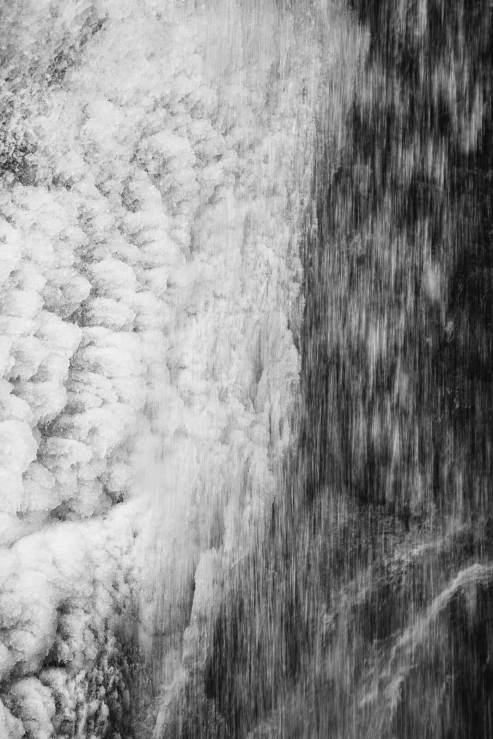Ice and snow, when fully embraced as photographic subjects, can be brilliant subject matter for creating beautiful abstract images.
Winter is my favorite season so when I find icy formations in creeks, rivers and lakes I’m definitely in my happy place.
Recently we published the work of Roland Krämer’s ice formations. This prompted me to share some of my own icy compositions and thoughts on getting out and finding abstracts in ice.
In search of ice
Here are a few of the best places to look for interesting formations:
- Along the edges of the shore
- Where there are trees, stumps, rocks or vegetation sticking out of the water
- Around dams or waterfalls
.mgl-tiles { display: none; } #mgl-gallery-634eda50d1d30 { margin: -5px; width: calc(100% + 10px); } #mgl-gallery-634eda50d1d30 .mgl-box { padding: 5px; } @media screen and (max-width: 768px) { #mgl-gallery-634eda50d1d30 { margin: -5px; width: calc(100% + 10px); } #mgl-gallery-634eda50d1d30 .mgl-box { padding: 5px; } } @media screen and (max-width: 460px) { #mgl-gallery-634eda50d1d30 { margin: -5px; width: calc(100% + 10px); } #mgl-gallery-634eda50d1d30 .mgl-box { padding: 5px; } }



To find the ideal locations for the best images keep the following in mind
- Watch for areas that have good contrast. Such as darker water against bright ice. The light, white ice against a dark rock. Soft grasses or other vegetation against hard ice.
- Look for places that have motion vs. static areas.
- Find streams that still have green moss and orange/brown rocks in them to contrast with the ice.
.mgl-tiles { display: none; } #mgl-gallery-634eda50d2bc5 { margin: -5px; width: calc(100% + 10px); } #mgl-gallery-634eda50d2bc5 .mgl-box { padding: 5px; } @media screen and (max-width: 768px) { #mgl-gallery-634eda50d2bc5 { margin: -5px; width: calc(100% + 10px); } #mgl-gallery-634eda50d2bc5 .mgl-box { padding: 5px; } } @media screen and (max-width: 460px) { #mgl-gallery-634eda50d2bc5 { margin: -5px; width: calc(100% + 10px); } #mgl-gallery-634eda50d2bc5 .mgl-box { padding: 5px; } }



Tips for creating compositions
- Use leading lines. Be aware of where the ice is coming into your frame.
- Watch for shapes within your viewfinder. Triangles, angles, curves and circles create fun and unique compositions.
- Keep it simple. Make sure there isn’t any extra clutter in your shot. No weeds sticking in or out of the frame for example.
- Get close. Now get closer. Grab your macro lens or your telephoto zoom to bring you right into the scene.
- Reflections. Using reflections can add depth to your image, even at close range.
.mgl-tiles { display: none; } #mgl-gallery-634eda50d37ac { margin: -5px; width: calc(100% + 10px); } #mgl-gallery-634eda50d37ac .mgl-box { padding: 5px; } @media screen and (max-width: 768px) { #mgl-gallery-634eda50d37ac { margin: -5px; width: calc(100% + 10px); } #mgl-gallery-634eda50d37ac .mgl-box { padding: 5px; } } @media screen and (max-width: 460px) { #mgl-gallery-634eda50d37ac { margin: -5px; width: calc(100% + 10px); } #mgl-gallery-634eda50d37ac .mgl-box { padding: 5px; } }


Don’t forget to just keep an eye out when you are out hiking or wandering in a park or even your backyard. Icicles are always fun to photograph as well. For instance, this image on the right below is a little piece I happened to see on a bridge at a local forest preserve. It was the only piece of ice on the bridge. I’ve included a full-size view of the bridge for scale.
.mgl-tiles { display: none; } #mgl-gallery-634eda50d3fd4 { margin: -5px; width: calc(100% + 10px); } #mgl-gallery-634eda50d3fd4 .mgl-box { padding: 5px; } @media screen and (max-width: 768px) { #mgl-gallery-634eda50d3fd4 { margin: -5px; width: calc(100% + 10px); } #mgl-gallery-634eda50d3fd4 .mgl-box { padding: 5px; } } @media screen and (max-width: 460px) { #mgl-gallery-634eda50d3fd4 { margin: -5px; width: calc(100% + 10px); } #mgl-gallery-634eda50d3fd4 .mgl-box { padding: 5px; } }


You have to be on the lookout to see such small details within the larger scene. For more tips and information about photographing winter check out the details in the landscape article.
Mother Nature is the ultimate artist, if you pay attention you’ll see far more beauty than you ever imagined.
All images (except for the wide bridge photo) were created with my Tamron 100-400mm f/4.5-6.3 Di VC USD Lens for Canon EF.
Tell your story with the second annual Visual Storytelling Conference!
Experience four days of interactive, online training sessions featuring a range of educational content with experienced photographers and content creators. This free event kicks off with a series of technical boot camps to build essential skills, followed by live, online sessions on photography, video, business and social media. Join live from March 10-13, 2022!
